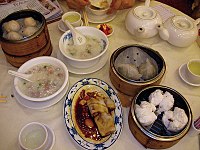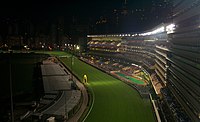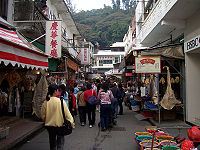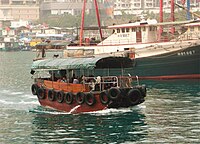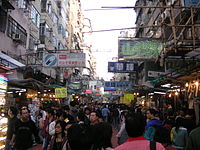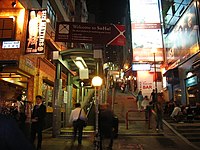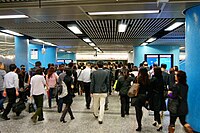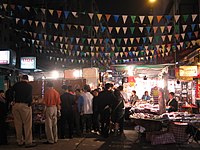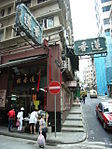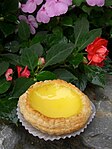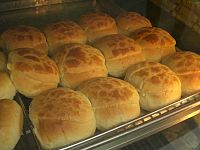Wikimania 2013/Bids/Hong Kong/zh-hant
Template:Other languages/Wikimania 2013/Bids/Hong Kong

- 體驗亞洲 聯動世界
在香港這個中西薈萃的亞洲國際都會當中,有著全球平均年紀最年輕,但組織了最多次聚會維基人社群。而且擁有連接世界各大洲的直航班機,還有很多國家的維基人皆可免簽證入境,更保有相對原裝的廣東文化甚至中華傳統,香港可謂是這個地區舉辦維基媒體國際年會的不二之選:亞洲的維基人能有機會學得更多,其他區域的維基人能親身體現亞洲。
- 城市: 香港
- 日期: 2013年8月9日(五) - 11日(日) (會議主要議程); 8月7 - 8日 (預備會議)
- 場地: 香港理工大學 (TBC)
- 預計出席人數: 700-1,000
- 聯絡人: Tango Chan (User:Tsugiko), Jeromy-Yu Chan (User:Yuyu)
簡介
亞洲國際都會
- 維基百科相關條目: 中文, 粵語, 日本語, 한국어, English, Français, Deutsch, Tiếng Việt, Tagalog, Bahasa Indonesia, ไทย, Português, اردو, العربية
香港〈英文:Hong Kong, HK, HKG〉,為實質上〈de-facto〉的城邦,中華人民共和國兩個特別行政區其中之一。 香港由香港島、九龍和新界三大部分構成,總計土地面積約1104 km²,常駐人口 700萬,是世界上密度最高城市之一。 香港位於南中國海沿岸,處珠江口東,逕出太平洋,北接廣東深圳,南眺萬山群島,西鄰澳門及廣東珠海。
During the colonial era, the territory espoused minimum government intervention from the British authorities and sheltered immigrants from different parts of the world, which resulted culture of Hong Kong, often described as "East meets West", with many of Chinese traditions well preserved, and different religions & ethnic groups coexist rather peacefully. Similar positive non-interventionism in economic policy, led Hong Kong to a status as one of the world's leading international financial centres, as well as a hub for regional transport and a famous tourism destination.
東西薈萃

Originally a fishing village on the edge of the Chinese Empire, the territory was changed forever when it becomes as an crown colony of the British Empire as the results of the First Opium War. The stability, security, and predictability of British law and government enabled Hong Kong to flourish as a centre for international trade, which attracted people from all over come and stay in Hong Kong, and brought in their own culture, religion and cuisines.
About 95% of the people of Hong Kong are of Chinese descent, the remaining 5% of the population is composed of non-ethnic Chinese which includes South Asian population of Indians, Pakistanis and Nepalese, Vietnamese and also Europeans (mostly British), Americans, Canadians, Japanese, and Koreans who are mostly working in the city's commercial and financial sector. In 2008, there were an estimate of 252,500 foreign domestic helpers from Indonesia and the Philippines working in Hong Kong.

The main religions in the territory are Buddhism, Taoism, Confucianism, and Christian with a nearly equally divided between Catholics and Protestants. There are also Sikh, Muslim, Jewish, Hindu and Bahá'í communities, coexists with each other peacefully. Minimum government intervention from the British authorities to the Chinese communities, also led to well-preserved Chinese tradition custom, in both indigenous residents in the New Territories, and immigrants from different parts of China in the down town. The preservation of tradition custom may well be observed especially during several Chinese traditional festivals such as Mid-Autumn Festival, whereas various celebrations and associated activities are performed and shown across the districts within the city.

區域樞紐


Logistics and trading is always bounded tightly together with the history of modern Hong Kong since from the origin, or the desired aim of setting up colonial Hong Kong, it was aimed as a trading port between the British Empire and the rest of oriental Asian countries, primarily the Mainland China during 19th century. The birth of Hong Kong were virtually a by-product under trading affairs and since then the city is survived, influenced and expanded inevitably bonded together with logistic characteristics.
Not long after the Second World War ends Hong Kong were benefited from its neighbours due to the relatively instabilities on politics of themselves. For several decades whereas cold wars and the disclosure with disagreement between China and Taiwan, practically it makes Hong Kong becomes a stepping stones on travelling and exchanging across two difference Chinese governance. The status as being a trading port also makes Hong Kong contributes a lot on driving the economical development into a new triumph, not limited to the city itself but also the whole East Asian region after post-war period.
Abbreviated as a part of the Rose Garden Project, the Airport Core Programme involves on a construction of today's Hong Kong International Airport and it's associated transport and infrastructural network were announced in 1989. Regarded as one of the architectural magnificence in the 20th century and lasted for 8 years of construction in total, the current airport located in Chek Lap Kok, Lantau was completed in 6 July 1998. In nowadays standards its construction is equivalent as lying a foundation stone on making the aviation activity of Hong Kong into a complete new era with much higher developing potential and handling ability compared with the previous Kai Tak Airport - infamous with it's proximity to the urban areas.
Nowadays travelling from and towards Hong Kong is a piece of cake, no matter from continents in the opposite of the globe or neighbouring regions. Hong Kong's airport is one of the primary transportation hubs in Asia and flights connections towards Asian countries are extremely frequent and served by variety of airlines. Geographically lying on the middle of the Kangaroo Routes on accessing to Australia, it's also one of the major regional stops of some Australian routes for stopovers towards Europe airports, especially United Kingdom. These making Hong Kong as the origin or destination of several world busiest passenger-carried air routes, such as routes between Sydney, London, Taipei, Tokyo and Beijing. It's accessibility and capacity makes the airport possesses a mixed characteristic on both regional and intercontinental - which is ideal as being a regional transferring hub.
旅遊觀光

Hong Kong is much more than a harbour city. The traveller weary of its crowded streets may be tempted to describe it as Hong Kongcrete. In the downtown, you can see lot of mix of Chinese and Western culture as well as modernity and ancient custom. From colonial style to ancient temple, old buildings are actually scattered among skyscrapers which dominate the skyline. These buildings together, with the world famous Victoria Harbour, forms the unique landscape of downtown Hong Kong.
Yet, this territory with its cloudy mountains and rocky islands is mostly a rural landscape. Much of the countryside is classified as Country Park and, although 7 million people are never far away, it is possible to find pockets of wilderness that will reward the more intrepid tourist, especially in somewhere you can look back the skyline of downtown Hong Kong. Also you are never far from the sea in Hong Kong and going to a good beach is only a bus-ride away.
Chinese culture is something worth exploring in the Hong Kong. From the crowded street markets to the rural indigenous villages in the New Territories, with Cantonese gourmet, Cantonese opera and Buddism-Taoism- Confusium all-in-one temple, these are the best preserved Chinese/Cantonese culture within the region, which is results of the lack of political turbulences in the history of Hong Kong.

美酒佳餚

Hong Kong is renowned as a world gourmet paradise. Owing to both British and Chinese influence, all kinds of cuisine are available in the city. Kowloon City, in particular, boasts a compendium of restaurants as a result of its proximity to the now-disused Kai Tak Airport. Although restaurants in general do not have the facility to serve food in conformance of religious standards such as halal and kosher; there are specialist halal and kosher restaurants in several parts of the city, especially associated with the areas where South Asians and Islamic communities lives and active.
As being a coastal city and a prolonged history on fisherman's activity, seafood are indeed one of the infamous ingredient of cuisines that may be found in most Cantonese restaruants in Hong Kong. From a simple and common local seafood restaurants, to the luxuries such as Jumbo Floating Restaurant or those seafood cuisine specialists in Sai Kung, it's definitely the ingredient which would make most of the chefs and diners fascinate with. Thanksfully to the immigrants of a variety of ethnicity over the decades in previous times, seeking for any other cuisines which sounds a bit more authentic or exotic, from traditional Cantonese to those other regions of the Mainland China or Taiwanese, also has a significant presence on the dining market shares within the city.
On the other hands, western and international cuisine may certainly be your alternative choices if you're preferring them. From Japanese cuisine in various price and classes, towards the choices of common steakhouses, bar and pubs, classical European cuisine or modern fusion inspired restaurant, even elegance British afternoon tea are all those may be founded within this broad spectrum of choices.
No matter what makes your meal during your stay, a visit to a "Cha Chaan Teng" is a must-try experience for understanding what's the most iconic cuisine of Hong Kong, as they originates a lots of fusion and combination from traditional cuisines into simple-and-cheap everyday meal which every Hong Konger typically consume everyday. Have a try with a ice-cold milk tea or red bean ice, serve together with some Hong Kong-specifically bakery such as egg tarts and pineapple buns for a short break of lunch in the noon.
On a ocassion if you are really struggled whether there's one to match your choices, depending on where you are, use OpenRice.com - a local search engine specialised to dining as a guidebook to search and match up your desire.
安穩太平

Since the recent several decade, Hong Kong is gaining a positive reputation continuously as being one of the safest cities among most of the metropolis with million-counted population over the world. It's achieved not only with a good natural factors whereas natural disasters such as earthquakes aren't presenting as a serious threat, but more importantly by the effort and efficiency on the civil security services. The Hong Kong Police Force is the world's second, and Asia's first, police agency to operate with a modern policing system. With a prolonged history and management, today it's one of the most efficient and clean policing force over the world and making Hong Kong has one of the lowest common crime rate among lots of city with such population size over the world.
Emergency aid and rescue service in Hong Kong also maintains as a world class standard with a service agreement on which ambulance received for a emergency call will arrive on scene in 8 minutes. The Fire Service of Hong Kong is also positively appreciated with it's highly efficient and qualitative performances in responding with accidents and disasters.
Consider with numerous million-city which was criticised with safety and whereas moving around may already be in a position of likely dangerous or troubles occur, Hong Kong is a city where safety is considered as one of the most important factors and living safe is a well-guaranteed factor and the civil security services are trust-able. In a case if safety issues or threats do occurs, police stations, and even police officers in patrol on the streets, may be easily found and useful assistance is more than usually may be provided. Emergency responses are also quickly and emergency services reach on scene within a timescale of few minutes.
四季氣候
The climate of Hong Kong is a monsoon-influenced humid subtropical climate (Köppen climate classification Cwa), just short of being a tropical wet-and-dry climate. In the winter, the weather is generally cool by local standards, with temperatures hovering between 15°C and 20°C. However, northeast winter monsoons bring frequent cold fronts which can cause the temperature to dip below 10°C, despite Hong Kong's tropical latitude and coastal location. Conversely, warm maritime airstreams also commonly raise the temperature well above 20°C. Temperatures as high as 29°C have been recorded in February. Winter starts sunny in December and becomes cloudier towards February.

- Four Seasons:
- Spring brings warmer and more humid weather. There is a sharp increase in rainfall around April. Spring is the cloudiest time of the year, with March and April both averaging only around 100 hours of bright sunshine.
- Summer weather is hot, humid and unstable. Thunderstorms and brief showers are common, as well as sunny conditions. August has the highest average rainfall of any month. Temperatures usually exceed 30°C during the day, which, coupled with a high humidity, can result in an extreme heat index. Extreme heat indices are also caused by continuous sunshine and low breeze, usually last long around July and August, is a result in subtropical high pressure areas. This also occurs before typhoons hitting Hong Kong or nearby regions in the northeast, e.g. Taiwan or Eastern Coast of China, such outbound airstream bring even hotter weather, in addition to dirtier air. Nights are also warm with an average minimum temperature of 26°C. Hong Kong is frequently hit by typhoons in summer.
- Autumn is generally considered as the most pleasant season. Temperatures are still high (20-27°C) while humidity and rainfall are considerably lower. Moreover, autumn is the sunniest season in Hong Kong, with October and November both averaging close to 200 hours of bright sunshine.

Our community
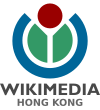
Hong Kong has one of the strongest Wikimedian communities in the Asia-Pacific region. In 2006, we organized the Chinese Wikimedia Conference 2006, the first ever regional Wikimedia conference. Wikimedia Hong Kong, the local chapter of the Wikimedia Foundation, was founded in 2007, and was among the earliest Wikimedia local chapters to receive charity status.
The first Wikipedian meetup in Hong Kong was held in 2005. Since then, Wikimedians in Hong Kong have been meeting regularly. By the end of 2011, we have organized a total of 60 meet-ups, more than anywhere else in the world.
Among the Wikimedian community, Hong Kong is best known for its youthful Wikimedians. According to Jimmy Wales during his visit to Hong Kong in 2006, Hong Kong has the "youngest Wikimedian community" in the whole world in terms of participants' age.
Our team


| Name | Areas of responsibility | Experience |
|---|---|---|
| Tango Chan (User:Tsugiko) | Bid Coordinator, Finance, Sponsors | Treasurer of the Hong Kong Chapter |
| Jeromy-Yu Chan (User:Yuyu) | Media & Program | Wikipedian since 2004, en, yue, zh, fr-2, de-1.5, Ex-President of Hong Kong Chapter Chinese Wikimedia Conference: Organizer 2006, Wikimania:Organizer 2007, Presenter 2009 & 2011, Attendee 2010 |
| Rover Wong (User:SusanLai) | Program, Local Community | President of Hong Kong Chapter |
| Vincent Tsui (User:Cehk) | Logistics | Secretary of Hong Kong Chapter, Organizer Chinese Wikimedia Conference 2006 |
| Terence Chau (User:manzheonchau) | Logistics | Admin Assistant of Hong Kong Chapter |
| Alan Lai (User:28481k) | Media & Program | Wikipedian since 2006, en, zh, yue, ja-1, fr-1 |
| Deryck Chan (User:Deryck Chan) | Program & Int'l Coordination | Sysop on en.wp, yue.wp, en, yue, zh, de-2, ja-1, Admin Assistant of Hong Kong Chapter, Organizer Chinese Wikimedia Conference 2006, Attendee Wikimania 2010, Presenter Wikimania 2011 |
| Simon Shek (石) | Program | Wikipedian since 2004, en, zh, yue |
| Samuel Chan (User:CX257) | Media | Admin Assistant of Hong Kong Chapter |
| Raymond Hui (User:Siuhyd) | General Help | Admin Assistant of Hong Kong Chapter |
| Calvin Siu (User:W.F. Siu) | General Help | Chairperson of The Council in Hong Kong Chapter |
If you are in the area and interested in helping, please e-mail us at wikimania <at> wikimedia <dot> hk .
Conference
Schedule
| Date | Wed 7th | Thu 8th | Fri 9th | Sat 10th | Sun 11th |
|---|---|---|---|---|---|
| Time | Pre-conference day 1 | Pre-conference day 2 | Main conference day 1 | Main conference day 2 | Main conference day 3 |
| Morning | Developer and board meetings | Chapters and board meetings | Opening ceremony Parallel Chinese and English sessions |
Keynote Speech |
Jimbo's Keynote |
| Lunch | Lunch break | Lunch break VIP party |
Lunch break | ||
| Afternoon | Developer and board meetings | Chapters and board meetings | Parallel sessions | Parallel sessions | Parallel sessions Closing ceremony |
| Evening | Welcome party | Beach party and barbecue | |||
Conference venue

After considering and approaching various possible venues, we've selected the Hong Kong Polytechnic University (PolyU) as our proposed conference venue.
The university is located in the Hung Hom area of Kowloon Peninsula, neighbouring the Hung Hom transportation hub which comprises Hung Hom Station and Cross-Harbour Tunnel. PolyU was founded in 1937 as a technical college, formally established in 1972 as a higher education college with degree-course education, and granted university status in November 1994. Today, PolyU has about 28,000 students reading 130 postgraduate, undergraduate and sub-degree programmes in various disciplines, including design, engineering, fashion and textiles, medical laboratory science, physiotherapy and radiography.
In recent years, the university achieved great academic triumphs in the field of computer sciences and technology among the Asia-Pacific and Greater China regions. Such academic excellence drives a strong appreciation and contribution potentials over the information technology industry of the region.
Regards with the details of associate facilities available are still in a consideration stage, the main conference location is proposed as being held in the Jockey Club Auditorium which locates inside the main campus, with a accommodation of 1,084 seats by its balcony and main hall seating. We're also intended to host the associated activities and sessions within the university coverage. The university management were also experienced on handling such activity as with its renowned previous experience as a venue provider with its local popularity.
Main hall
The Jockey Club Auditoriumis one of the main auditorium managed by the university, and it's designed as to fulfill a capability of hosting a variety of functions including public talks, ceremonies, conferences, seminars and even as performing arts. The auditorium is configured as a balcony-included theater layout with 702 fixed seats on the main floor and 323 balcony seats, with additional temporary seats may be provided. The auditorium also consists a main entrance foyer right above it's main hall level, which is ideal for setting exhibition stands and providing space as reception area of the conference.
Apart from the grand opening, we're also intending to arrange some sessions which may contains a foreseeable number of guests to be also held in the main auditorium regards with its high capacity.
Seminar rooms
PolyU also provides numberous of seminar classrooms in 30-100 seats which makes available for smaller seminars, interactive group sessions, or administrative area for the attending organisations, just like the sessions of Wikimania. Lecture theatres in various capacity in either 80-160 seats or larger ones which may houses above 160 attendees are also available and we're intending to use them as venue on holding several minor public talks session during the timespan of conferences.
Other rooms
Apart from public sessions, we're also expecting that attending organisations, especially local chapters, company firms and press would be active constantly throughout the timespan of conference and often associating workspaces are required on site. Therefore during on planning about the exact numbers of rooms required, we're awaring to reserve extra seminar rooms and reconfigure them in possible scale as specifically suits for press and administrative section, allowing interviews, activity backup for local staff and volunteers, press activity and administrative work may be maintained concentrately in designated areas.
Socializing areas
The auditorium associates with an open-air amphitheatre area outside its entrance foyer, and we're intended to configure the particular area for various open-space seating, public exhibition and associated activity. Accommodating up to 200 spectators, the tiered amphitheatre of approximately 1,100 square metre is ideal for informal gatherings.
As well as the open-air amphitheatre, the University can also arrange covered areas on the podium nearby the Auditorium, which would be available for catering and other purposes.
Contacts with conference venue
The team is rather well-connected with the University. The team is currently talking with M-lab under the School of Design of the University, consulting the relevant management personelle with the availability of the Main Hall and other rooms, and we can book through M-Lab. Through our partner dotAsia, we can also reach the management of the University, and get further support on using different facilities of the university. WIth the help from the M-lab, we will try to negotiate with the University management to get a discounted price or even waive the rent for such facilities.
Technical facilities
The main auditorium facilitates with a series of essential equipments in a theatre standard, including built-in cinematic projection and audition system, standard modern stage fly system and lighting facilities. Seminar rooms are equipped with overhead and LED projector with screens and audio system, making them ideal on performing presentations or discussion. Furthermore the lecture theatres are additionally equipped with both VHS and DVD players, as well as slide projector. Wired and wireless microphones are also provided on-site within the theatres. We believe that the flexibility and variety of room sizes may be provided are able to suit with various usage of attendees accorrding to their desire and property on the session and talks. Although the rooms will yet available to be booked until December 2012 regards with the proposing date of the conference, once the bidding is successful we're trying to negotiate with the University management to making the room booking available in a higher priority as to ensure plenty of rooms may be provided during the conference.
Wireless Network implementation
The whole university campus is covered by built-in WLAN Wi-Fi system which is operated by the university. We will seek for a sponsorship from local telecom companies, to provide extra bandwidth & routers for the venue and some of the accomodations.
Location and Transportation

The university is located right next to MTR Hung Hom Station and the Cross-Harbour Tunnel Bus interchange and the main entrance locates just above several footbridges which connect across the university campus on a above-ground level and the station, flying over the bus interchange and toll booths. Follow exit A from the station and walk along the footbridge towards the series of red-brick coloured buildings, which is the university's main campus. MTR Hung Hom stations is served by the East Rail Line and West Rail Line, two mainstream suburban railway routes of the city.
On the other side the bus interchange is served by virtually all harbour-crossing bus which passes the Cross Harbour Tunnel (with a 1-prefix on their number, e.g 101,104,107,118) and they're reachable from either the Kowloon Peninsula or Hong Kong Island. Any other bus routes which call at Hung Hom Station terminus are also accessible to the university from a walking distance. Additionally Citybus Cityflyer route A21 terminates at Hung Hom MTR station therefore the campus is virtually also accessible directly from the airport by airport buses.
The campus also has a entrances facing towards the Austin Road junction with Cheong Wan Road, right opposite with Hong Kong Museum of History. It takes a 10 to 15 minutes walking distances from Nathan Road in either Jordan or Tsim Sha Tsui, the most vibrant and transportation-accessible region of the Kowloon Peninsula, into the main campus. This entrance is also accessible for either motor vehicles or taxicabs, by traffics entering from Cheong Wan Road.
Party opportunities
Attendees party: beach barbecue

- Date: last day of main conference (11 August 2013)
- Time: late afternoon to midnight
- Venue: Siu Lam Barbecue By The Beach
The proposed venue, Siu Lam Barbecue By The Beach, boasts long-standing experience of hosting large-scale social events for organizations, and has a capacity of 3000 attendees. Situated on the shore of Castle Peak Bay, otherwise known as the Hong Kong's "Gold Coast", the venue offers a sandy beach perfect for swimming and sun-bathing in the summer sunset, in addition to the obvious: a barbecue buffet dinner for all attendees.

The venue operates traditional Hong Kong-style barbecue (en, zh). Unlike Western barbecues where a chef cooks meat and vegetables for everyone on a grill, in a Hong Kong-style barbecue everyone sits around an open charcoal fire, and cook their food using long barbecue forks. The environment is described as being "more similar to a fondue or campfire than a barbecue", and provides an ideal opportunity for socializing, or even wiki-style collaboration on cooking! A buffet barbecue is provided, which means unlimited amounts of uncooked food is supplied centrally. From there everyone collects raw food as they desire, and cooks them on their own fire.
Coaches will be arranged to transport attendees between the conference venue and the party venue immediately after the end of the main conference. We aim to arrive at the beach with ample time to spare before sunset. After the party, coaches will take attendees from Siu Lam to the conference venue and accommodation.
VIP party
We are currently planning to have a decent Cantonese-style lunch reception in one of the hotel in Tsim Sha Tsui East, nearby the venue.
Welcoming Party
We are also looking for a venue in the most famous hang-out of the town, Lan Kwai Fong in Central on the Hong Kong Island, to have a welcoming party, for those who will come to the pre conference.
Logistics
Getting to Hong Kong
|
Air travel: Hong Kong International Airport (IATA: HKG) is a leading air passenger gateway and logistics hub in Asia. Located on the island of Chek Lap Kok, 34 km/21 miles from downtown, HKG airport has scheduled non-stop flights operated to more than 150 cities. Regarded as a focus city or major transfer hub by major airlines, the two-terminal airport is where more 85 airlines operate at and it is the primary hub of Cathay Pacific, Dragonair, Air Hong Kong, Hong Kong Airlines, and Hong Kong Express. In 2010, the airport was named the World’s Best Airport in the annual passenger survey by Skytrax for the eighth time since 2001. The home airlines - Cathay Pacific and Dragonair, were also granted as the Best Airline of Year 2003, 2005 and 2009 and the Best Airline of Greater China region by Skytrax respectively. The airport itself operates in 24 hours, 7 days a week.
 |
 |
 |


Hong Kong International Airport is accessible with the MTR Airport Express train service, and its service may reach towards both Kowloon Peninsula and Hong Kong Island. Hong Kong Station is the termini of the route and extensive network of local bus services may be interchanged from every stations. There are also a extensive Airport buses network served by both Citybus and Long Win Bus. These lines were represented as a A- or E-prefix in front of their bus routes, and the bus network may reach to most urban areas covering Hong Kong Island, Kowloon, and most towns in New Territories.
Rail: Inter-city train services crossing the Hong Kong-China boundary are known as Intercity Through Trains. Currently, Hung Hom Station (Kowloon/Jiulong) is the only station in Hong Kong where passenger can catch these trains. Passengers have to go through immigration and custom inspections before boarding. There are currently three through train routes:
- Between Hong Kong and Beijing
- Between Hong Kong and Shanghai
- Between Hong Kong and Guangzhou
However, the East Rail Line, one of the metro lines inside the Hong Kong's Metro network (MTR) also connects to two of the boundary control point - Lok Ma Chau and Lo Wu. Both of the station provides a accessibility towards Shenzhen, and interchangeable with the Shenzhen Metro on the opposite of border on Chinese side. A journey from the border towards Hung Hom Station cost approximately 40 minutes. Additionally Lo Wu Station is interchangable with the CRH High-speed Railway network of Mainland China across the border, which runs a more frequent services between Shenzhen and Guangzhou.
Ferry and Marine: Hong Kong contains two main ferry terminal which serves by the Hong Kong-China boundary crossing ferries services:
- Macau Ferry Terminal - Sheung Wan, Hong Kong
- China Ferry Terminal - Tsim Sha Tsui, Kowloon
and these two ferry terminals are accessible with MTR and local buses services.
Regardless with their name, both of these ferry terminals provides extensive network of ferry services towards BOTH various cities within Guangdong Provinces, China and Macau. However China Ferry Terminal contains a more frequent and extensive network towards China than its counterpart, while Macau Ferry Terminal provides a 24 hours ferry services towards Macau which its counterpart doesn't. Be aware of that ferries which terminates at Hong Kong International Airport, from either Macau or Shenzhen, may only accessible to the departure hall of the airport (as simliar as a flight transfer) by arriving the Skypier and it's not possible to travel right back into the city in such case.
Although as a less-likely option of transportation, cruises services also serves Hong Kong and the cruise terminal of Hong Kong - Ocean Terminal locates in Kowloon Peninsula, right next to the Star Ferry at Tsim Sha Tsui. Cruises service on a scheduled or regular basis from here travels across the Asia-Pacific regions and may usually reach as far as Singapore or Japan.
Bus & Roads: Hong Kong has convenient cross-border bus services to many cities in Guangdong province including Shenzhen, Guangzhou, Dongguan and etc. Tickets are purchasable either in mainland China or Hong Kong, services and operators varies depending on the exact location you're desired to travel. Road connections across boundary checking points are possible and vehicles with specialised license may be accessed across border. Several checking points connects with the expressway network of Hong Kong including Lok Ma Chau-Huanggang and Shenzhen Bay Port. Additionally most cross-border buses likely uses these two particular ports on their jounery.

Visa
We believe Hong Kong is one of the most friendly territories in the world on visa policy. Nationals of about 170 countries and territories, including most European & American States as well as British Commonwealth nations, may visit Hong Kong visa-free for a period ranging from 7 days to 180 days.
Visa Free
Citizens of the following countries do not need a visa in order to enter Hong Kong SAR:
180 days
90 days
 EU and EFTA Nations (except UK citizens)
EU and EFTA Nations (except UK citizens)
 Andorra
Andorra Antigua and Barbuda
Antigua and Barbuda Argentina
Argentina Australia
Australia Bahamas
Bahamas Barbados
Barbados Belize
Belize Botswana
Botswana Brazil
Brazil Brunei
Brunei Canada
Canada Chile
Chile Colombia
Colombia Dominica
Dominica Ecuador
Ecuador Egypt
Egypt Faroe Islands
Faroe Islands Fiji
Fiji The Gambia
The Gambia Greenland
Greenland Guyana
Guyana Israel
Israel Jamaica
Jamaica Japan
Japan Kenya
Kenya Kiribati
Kiribati Malawi
Malawi Malaysia
Malaysia Maldives
Maldives Mauritius
Mauritius Mexico
Mexico Monaco
Monaco Namibia
Namibia Nauru
Nauru New Zealand
New Zealand Papua New Guinea
Papua New Guinea San Marino
San Marino Seychelles
Seychelles Singapore
Singapore South Korea
South Korea Saint Kitts and Nevis
Saint Kitts and Nevis Saint Lucia
Saint Lucia Saint Vincent and the Grenadines
Saint Vincent and the Grenadines Republic of China (Taiwan)
Republic of China (Taiwan)
- Taiwan Compatriot Entry Permit Obtainers only
 Swaziland
Swaziland Tanzania
Tanzania Tonga
Tonga
- Except Tongan National passports, Tongan Protected Persons passports
 Trinidad and Tobago
Trinidad and Tobago Turkey
Turkey Tuvalu
Tuvalu
- Except those with national status stated as 'I-TUVALU'
 Uruguay
Uruguay United Kingdom
United Kingdom
- British Overseas Territories Citizens
- British Overseas Citizens
- British Subjects
- British Protected Persons
 United States
United States Vanuatu
Vanuatu Venezuela
Venezuela Zambia
Zambia Zimbabwe
Zimbabwe
30 days
14 days
 Algeria
Algeria Benin
Benin Bhutan
Bhutan Bosnia and Herzegovina
Bosnia and Herzegovina Burkina Faso
Burkina Faso Central African Republic
Central African Republic Chad
Chad Comoros
Comoros Croatia
Croatia Djibouti
Djibouti Equatorial Guinea
Equatorial Guinea Gabon
Gabon Guinea
Guinea Guinea-Bissau
Guinea-Bissau Haiti
Haiti Holy See
Holy See
- excluding service passports
 India
India Lesotho
Lesotho Macedonia
Macedonia Madagascar
Madagascar Mali
Mali Marshall Islands
Marshall Islands Mauritania
Mauritania Federated States of Micronesia
Federated States of Micronesia Mongolia
Mongolia Mozambique
Mozambique Niger
Niger Palau
Palau The Philippines
The Philippines Russia
Russia Rwanda
Rwanda Sao Tome and Principe
Sao Tome and Principe Serbia
Serbia
- biometric passports only, except those issued by the Co-ordination Directorate in Belgrade
 Suriname
Suriname Ukraine
Ukraine
People's Republic of China
Chinese nationals with a hukou registration in Mainland China are required to obtain an entry permit from the Public Security Bureau for any type of visit to Hong Kong (short visits and long visits alike, including settlement). However, an exemption is made for Mainland Chinese passport holders who are transitting through Hong Kong to a third country. In this case, a visa waiver is available for those whose stay in Hong Kong lasts a maximum of 7 days and who can prove their onward journey.
Non-Chinese nationals living in other parts of the PRC are treated on the basis of their nationality, whilst Chinese nationals living in other parts of China who do not possess the right of abode in Hong Kong are treated based on the region in which they have a right of abode or household registration.
Cost
Estimation of air-travel costs from all continents
Hong Kong is one of the dominant regional hub in the Asia-Pacific with numerous of carriers providing scheduled flight services from and towards the city. The following table shows a selection of destinations and carriers with their associated fares. The fare is referenced with a departure date in 7 August 2012 from the origin airport, with a returning trip on leaving Hong Kong in 12 August 2012.
Flight taxes and fees are included, however, additional airline fees for baggage or fuel may apply.
Latest update on 26JAN2012.
Tourism opportunities

- Macau, the former Portuguese colony and present largest gambling haven in the world, is just an hour away by TurboJet [1] ferry. It was the first European enclave in East Asia, and a major trading port from its founding in the 1500s. Today its main attractions are casinos, European food and wine, and old colonial buildings. Ticket prices start at $18 for the one-hour ride to Macau. The ferry building is near the Sheung Wan MTR station on Hong Kong Island. Less frequent ferries are also available from New World First Ferry [2] in Tsim Sha Tsui, Kowloon and the Hong Kong International Airport.

- Shenzhen, mainland China's boomtown just across the border can be reached by MTR train services in about 40 minutes. The train is convenient if you are keen on shopping as it terminates in the Lo Wu commercial centre. Another alternative, especially if you are starting from the island is the ferry to Shekou which takes around 50 minutes and costs around $13. Note that if you aren't a Hong Kong resident, Japanese nor Singaporean citizen, you will need to pre-arrange a visa to enter Shenzhen.
- Guangzhou, capital of mainland China's Guangdong Province, which was known as Canton in the tea-clipper era. Guangzhou is thousands of years old and has always been the most important city of Southern China. It is also considered the root of the Cantonese culture in Hong Kong, Macau and all over the world. Guangzhou can be reached by train within 1 hour 30 minutes to 2 hours, depending on Guangdong Line [3]. If you are on a budget, many cross border buses are available throughout Hong Kong. The trip will take more than 3 hours, including going through customs at the border and changing buses. Check bus schedules and fares online [4].
Also, there are several nearby areas in South China that are well worth visiting:
- Guilin and Yangshuo for famous mountain and river scenery, possibly returning via Southern China's greatest city, Guangzhou.
- Hainan for tropical beaches.
- Wu Yi Mountain for history and scenery, returning via the lively modern city Xiamen.
- Yunnan, home to many of China's minority ethnic groups and a very popular tourist destination, where the self-proclaimed Shangri-La County locates.
Accommodation

The venue, the Hong Kong Polytechnic University, is located near Tsim Sha Tsui, where you can find most accommodations available among different districts of Hong Kong, including a variety of hotels and hostels that only take you less than 10 minuted walking.
In the eastern part of Tsim Sha Tsui, next to the venue, are most of high end hotels locates. There are a few more 5 star hotels further down the waterfront Tsim Sha Tsui, and few more are, connected with a major shopping mall in town Harbour City, in Tsim Sha Tsui West. Here are some more high-end hotels which marked at more than 65 USD (~1,000 HKD) per night. The prices in this list had already calculated the early-bird discount for booking, although we will try to get better price if our bid is sucessful.
| Hotel | Location | Budget (USD) |
|---|---|---|
| Kimberley Hotel | 28 Kimberley Road | 65.72 |
| Harbour Plaza 8 Degrees | 199 Kowloon City Road | 74.10 |
| Regal Kowloon Hotel | 71 Mody Road | 76.68 |
| Metropark Hotel Kowloon | 75 Waterloo Road | 83.76 |
| Harbour Grand Kowloon | 20 Tak Fung Street | 98.58 |
| The Luxe Manor | 39 Kimberley Road | 103.09 |
| Regal Oriental Hotel | 30-38 Sa Po Road | 115.98 |
| Hotel ICON | 17 Science Museum Road | 123.71 |
| The Mira Hotel | 118 Nathan Road | 148.20 |
| InterContinental Hong Kong | 18 Salisbury Road | 174.74 |
| The Marco Polo (Gateway) |
13 Canton Road | 180.41 |
| The Marco Polo (Hong Kong Hotel) |
3 Canton Road | 215.85 |
There also diffent hostels and budget hotels, locally referred as "Guesthouses", scattered all over the Kowloon peninsula, and most of them are located in nearby Tsim Shui Tsui & Jordan, and a few in Hong Hum.
Here is short list that included some hotels which priced around 40 USD for one night.
| Hotel | Location | Budget (USD) |
|---|---|---|
| Bridal Tea House Hotel (Winslow Street Branch) |
57-61 Winslow Street | 34.15 |
| Bridal Tea House Hotel (North Wing, Wuhu Street Branch) |
84-86 Wuhu Street | 35.44 |
| Bridal Tea House Hotel (South Wing,Wuhu Street Branch) |
69 Gillies Avenue South | 37.37 |
| Acesite Hotel | 106-108 Soy Street | 38.66 |
| Hotel 36 | 36 Boundary Street | 40.59 |
| Caritas Lodge | 134 Boundary Street | 42.53 |
This is an average cost for a twin-room with two separate beds for one night to each person.
Besides that, most of the hotels and hostels located in Kowloon Peninsula would only take you within 30 minutes to the Hong Kong Polytechnic University by public transport.
We are also seeking a summer booking of the dorm of the PolyU itself, which can accommodate 3000 guests in full capacity, and other possible hostel option in downtown Kowloon.
Local transport

Hong Kong has a highly developed and sophisticated transport network, encompassing both public and private transport. Over 90% of the daily journeys are on public transport, making it the highest rate in the world. Hong Kong also possesses one of the safest, also cheapest, transportation network throughout most of the major cities in the world. Therefore unlike lots of large cities whereas safety and crime on public transportation is always criticized and gaining a negative reputation towards visitors, travelling around Hong Kong with public transport in most case is always confident in safety and economically favorable, making it gains a high positive reputation on a safe, clean and accessible system in comparison with lots of cities over the world.
Hong Kong also was one of the first cities to apply, and currently the most advanced city on application with using smartcards as electronic payment, especially on transportation fare systems. The most convenient way to pay the fares while travelling around is to purchase a Octopus Card once arrived Hong Kong. They are purchasable on every MTR stations and hundreds, if not thousands, of convenient stores and shops everywhere around the city. "Add value" (top-up) services are also available on all of these locations, and the payments isn't only limited with transportations but also widely accepted on purchasing everyday goods in various shops, making itself as one of the most widely-used electronic purse systems in the world. Of course, nearly all public transports accepts Octopus Cards as payment.
Due to it's extensive and complexity of the network contained in the city, often a same journey may be provided by different more of transportation or similar while different routes may be seen from the network. However you don't have to panic since most services are interconnected and major station provides assistance help or customer service centres and hence even you're lost you may get re-connected on the way you desired with another services. Brief descriptions on how to use it's enriched transportation system is described as below.





- MTR: As told from it's full name - Mass Transit Railway, it's currently being the metro-train services operator of Hong Kong, providing a convenient, network-extensive, and primarily the most efficient mode of transportation on travelling across different districts of Hong Kong. Fare ranges from approximate HK$3 towards HK$30s depends on the travelling distance and districts. All metro stations are accessible with franchised bus services, and some, although Airport express is provided by MTR system (but in a relatively higher fare than buses), are accessible with Airport buses. If you're travelling Airport Express with associating a connection with another MTR routes a discounted fare is included on that particular connection journey.
Hong Kong Station, as the termini of Airport Express, located in the heart and the business financial centre of the city - Central. Kowloon Station is also reachable by local buses and walking distance from Jordan area. In-town check-in services and feeder buses between major hotels within urban areas and Hong Kong/Kowloon Station is provided and they're complimentary for passengers who're travelling with Airport Express from/towards these two stations. A journey between Airport and Hong Kong Station costs about 24 minutes. All general metro stations (as shown on the map above), and limited number of light rail station are staffed with information booth and shops, especially convenient stores and ATM are available on most stations.
MTR also operates a series of local feeder bus routes (mostly beginning as K -prefix) in the suburbs of the New Territories including Tuen Mun - Yuen Long region and Tai Po. They're aimed to act as assistance and connection from local areas into it's railway network and fare discounts may be provided on travelling them with associating a light rail or mainline rail connection.
- Buses: Buses in Hong Kong operates in franchise-operations with routes runs by different operators. Majority of routes runs by particular company, while harbour-crossing routes are often jointly-operated by two bus companies. Although looks complicated from a simple scratch, route numbering in Hong Kong are based on the types of route and the districts where they serve. There's are still some simple facts that may be applied to make a rough understanding about where the bus is going to take you towards.
- Bus routes in Kowloon Peninsula and New Territories shares a same numbering system. While on the other hand the whole Hong Kong Island has it's another own numbering system. Which means, there's a pair of route using a same number while completely independent to each other. For example 1 in the Island and 1 in Kowloon aren't related to each other.
- Harbour Crossing and Airport routes however, are using a same numbering system throughout the whole Hong Kong. Routes with a 100, 600 or 900 prefix are harbour-crossing, such as 102, 680 and 962. If you see a such bus in Hong Kong Island this means it's going to carry you across the harbour towards Kowloon or New Territories, and of course, vice versa if you're somewhere in Mong Kok or Shatin.
There are currently five franchised bus companies in Hong Kong:
- Kowloon Motor Bus, branded as KMB, one of the largest privately-owned bus companies in the world, also the dominant operator in routes of Kowloon Peninsula and New Territories. It has a second highest market share among all transportation in Hong Kong, behinding MTR. Unique design on red-coloured circular-shape routes indication over their bus stops is a symbolic characteristic of KMB. Common type of transportation if you're moving around Kowloon and New Territories.
- Long Win Bus, one of the airport bus operators. Unlike Citybus it has a independent franchise on it's airport buses service while it has a heavy correspondence with KMB - its mother company. Routes mainly serves between New Territories and Airports, as well as Tung Chung - the supporting town of the Airport.
Company and route details of both Long Win Bus and Kowloon Motor Bus may be found in a same website as [[5]].
- Citybus, is one of the two main bus companies in the Hong Kong Island, it also operates several crucial bus routes which link some city centre regions of Hong Kong Islands with various destination in Kowloon and the New Territories. Compare with counterparts Citybus has a relatively denser network on some trunk routes, in other words it would be the artery on the aspect of road transports over the Island. Easily recognised with a yellow livery covering the whole body containing red and blue bands underneath the bottom edge of the vehicle.
- New World First Bus, or commonly knows as First Bus due to it's previous ownership by First Group of Britain, hence it's company name. One of the two dominant bus operators in Hong Kong Island, with a relatively minor network serving part of Kowloon and New Territories. Concentrating significantly on a local networks on Hong Kong Islands, although normally some routes would have a rather faster and trunk route alternatives by Citybus which is currently in a same co-operational group with First Bus. Still, it operate some trunk bus routes to several specific locations and harbour-crossing buses.
- New Lantao Bus is the primary operator of local bus service within the Lantau Island. It's service especially focused on the routes covering the southern region of Lantau since the road network of the area are restricted for access. During holiday vacations and weekend leisure activity
they're the most common method on accessing the major tourist and leisure countryside area on the island. Services also available in weekdays however trip fares are generally higher during weekends.
- Trams: Established in 1904, it's one of the oldest tramways in the world which remains operation today, especially majority of it's track is still following as a same alignment since it was built. Also among with the Blackpool Tram in Britain, it's the one of the world only two double-decker trams in operation. Therefore the tramway itself, not act as only a mode of everyday transportation but also possesses a tourism value while travelling them. The main tramway it follows was roughly whereas the coastline of Hong Kong Island lies in a century ago, and journey travels across the modern finance centre of the city, from those sectors whereas both Europeans and Chinese concentrated respectively in the past, and the area where it's used to called as 'Victoria City' in the West, to the authentic everyday-life scene of common Hong Kongers around district such as Shau Kei Wan or North Point in the East. Fares are very cheap, as HK$2.3 for adult, HK$1.2 for children and HK$1.0 elderly, regardless the distance traveled the tramway shares the same fare for any single journey. The price of tramways is often, although it's still very cheap in terms of fares standards with most cities, cheaper than the parallel routes which may be reached by using buses or MTR.
- Ferry: Ferry services of Hong Kong may mainly be divided into the following three types of services according to their characteristics. Harbour-Crossing routes are the ferries services which travel between Hong Kong Island and Kowloon by crossing the Victoria Harbour. One of the services regarded as such is the distinctive and well-known Star Ferry which serves between Tsim Sha Tsui and Central or Wan Chai of Hong Kong Island and it's often advertised as one of the 50th must-see sightseeing spots over the globe by the National Geographic, as well as numerous of travelling publications.
Hong Kong has a significant numbers of small outlying islands in its territory and ferry services often becomes a dominant, if not the only, transportation mode for these islands, as well as travelling to South Lantau in a more direct routing from the urban. Some islands are especially populated or popular for tourism are well served by frequent ferry services, for example Cheung Chau and Lamma Island as famous local countryside spot and resorts. Most of the services in such type departs from the Central Piers - The transportation hub of domestic ferry services in Hong Kong. The following operators has a significant ferry services network across the harbour and islands.
- New World First Ferry - NWFF
- Hong Kong Kowloon Ferry - HKKF
- Discovery Bay Transport and ParkIsland Ferry, however they're designated to provide transport linkage towards their parental suburban property developments.
There's are also some relatively smaller ferry services voyaging between remote islands, or countryside area which may not accessible by road. They're however operated by local operators and service detail and schedule may vary.
- Taxis: The service area of taxicabs in Hong Kong are divided into three parts by the Government, which is regarded as Urban Taxi, New Territories Taxi and Lantau Taxi, the scheme is designed to avoid clustering of taxis into the most populated or profitable areas in the territory. The types of taxi are following:
- Urban Taxi: Which serves all the territory, mostly Kowloon & Hong Kong Island; pick-up on Terminal 1 &2, Ground Transportation Centre of the Airport, Tung Chung, Disney Resort and New Territories are accepted only if passengers on-board are returning to Kowloon or HK Island, vice versa if passengers are going to the destinations above departed from Kowloon or HK Island. While crossing the Harbour, try to hire a taxi at a harbour-crossing taxi stand where passenger only pays the singular tunnel tolls, instead of twice from ordinary stands.
- New Territories Taxi: As the name implies, N.T. Taxis serves most of the New Territories (New Kowloon and some New Towns were excluded since merged as a part of urban area), also other specified areas. They're cheaper in fares but forbidden on serving within Hong Kong Island and majority of Kowloon, and therefore their service area is limited.
- Lantau Taxi: Lantau Taxi is designated to serve the Lantau Island theoretically; it's service area includes the Disney Resort; Airport Terminal 1 &2, Ground Transportation Centre of the airport and major towns of the Island can be reached. Discovery bay is however inaccessible since the roads within Discovery Bay are private roads and taxis are forbidden by the property management.
For further information regards with fares and by-laws additional charges (e.g luggages, tolls), please refer to the websites of the Hong Kong Tourism Board [6], or the Transport Department [7].
Local social opportunities
The venue is next to Tsim Sha Tsui (尖沙咀), where is the most popular hang out of the locals, with many shopping malls, gourmet, bars, cafés and even cultural experiences. You can also find a lot rather local gourmet in Jordan (佐敦), the neighborhood just north to Tsim Shui Tsui.

- Kowloon Waterfront, offers splendid views of the Hong Kong island shore and skyline. This is the best place to experience the classic view of Hong Kong, and nobody on their first trip here should miss out on promenading along the waterfront. The best views are to be had at night when the lights of global capitalism provide a powerful spectacle. Every night at 8 PM there is a colourful light show, called "A Symphony Of Lights", that is staged atop the key buildings on both sides of the harbour.
- Nathan Rd is the main artery of Kowloon peninsula, where shows you a typical Hong Kong urban landscape, a chaotic mixed of skyscrapers and Cantonese style old buildings, of merchandising stores and residential buildings, where you can even see an Anglican Church within such mix. Once referred "Golden mile" of Hong Kong, the scene with full of chaotic neon signs hanging from the building is also world famous . It is also a major shopping strip for both locals and visitors, with all kinds of small stores to huge department store, where you can almost buy most of daily need, clothes, electronics (though we don't recommend you buy here) etc.
- Tsim Sha Tsui also is a major shopping area for locals & visitors with a number of major Shopping Malls in the area. You can find most of the world-famous luxury brand in these mall, although they're mostly flock with tourists from Mainland China.
- Knutsford Terrace, near the Miramar hotel is perhaps best described as the 'Lang Kwai Fong' of Kowloon, and has a large number of bars and restaurants of variable quality that cater for mid-range budgets. A little smaller and less phrenetic than Lan Kwai Fong, but well worth the effort to poke your nose along this narrow street on a Saturday evening.

- Ashley Road, between Nathan Road and the Ocean Terminal shopping mall, features many Western restaurants and bars.
- You can find a variety of gourmets in Carnarvon Road & Lok Rd, where locals go there to feed themselves, from Cantonese Cha chaan teng to French cuisine, Teochow rice noodle to Indian curries even Turkish Kebab.
- Take a walk in Kowloon Park where you will find not only pleasant gardens but aviaries, museums, and sporting facilities including Hong Kong's best swimming pool complex which offers both indoor and outdoor pools. A wide-range of swimming, diving and children's play-pools will appeal to kids of all ages, and their frazzled parents who are seeking a safe place for youngsters to play away from the traffic.
- Temple Street south of Mong Kok is a great place to eat Chinese street food. You have not been to Honkers unless you have eaten in this street. Temple Street, famously featured in Chinese cinema, is one of the few pedestrianised streets in Kowloon where you can sit, relax and watch the world pass by. Seafood is a popular choice, but most restaurants will provide you with an extensive English/Chinese menu that caters for most tastes. Frog is a tasty option, or try the oyster omelettes.
- Parkes St is another area you can find variety of gourmets, including Cantonese, Shanghainese, Japanese, Korean, Vietnamese, Taiwanese, Thai cuisines. A small shop named Australia Dairy Company is total reflection of Hong Kong efficiency, as each guest has only 10 minutes to enjoy their dairy desserts.

- The immediate area northwest of Jordan Rd and Nathan Rd in Jordan contains a kaleidoscope of cultures and people from India, Laos, Cambodia and other Southeast Asian nations. Many of them have opened restaurants with authentic cuisine of an international flavour. There are also street restaurants offering Chinese-style seafood, where you can closely view fish, shrimp or crab before being slaughtered for your order. Although the neighbourhood looks rundown, it is safe and filled with pedestrian and vehicular traffic almost around-the-clock. At night, you'll likely get solicited for patronage by restaurant employees.
If you would like to go further, you can either take East Rail Line to Mong Kok East from Hung Hum Station , or take buses to different hang outs on the Hong Kong Island, from the Cross Habour Tunnel Bus Terminius. Both the train station and the bus terminus are next to our venue, PolyU
- Mong Kok (旺角) has a huge choice of shops and markets in an area of less than a square kilometre. You can also find many Cafés, and gourmets from local street food, to high end Western dishes. It is also a rather local hangout, where you can find clothes, sports shoes, electronic gadget and karaoke. Visitors may find Tong Choi St & Fa Yuen St interesting, as they are the few remaining street market in the territories.
- Wan Chai (灣仔) is much more than a couple of blocks of girlie-bars populated by drunken American sailors; after all, the World of Suzie Wong was just a work of fiction set in Wan Chai during a bygone age. Located between Causeway Bay and Admiralty, Wanchai has an inner-city feel that makes it an interesting but safe area to walk around at any time. Wan Chai has traditional street markets that, unlike many other neighbourhoods, are still outdoors. In the so-called wet-markets, butchers hang animal carcasses on large hooks that overshadow pavements and fishmongers have stalls with live fish that do their best to escape. Between Johnston Road and Queen's Road East are numerous alleys that are worth exploring if you are looking for traditional family-run shops selling anything from tropical fish to cheap clothing.

- Central (中環), previously known as Victoria, this is 'downtown' Hong Kong and maybe defined as the area within walking distance of Central MTR station. Head north towards the harbour and you will find modern buildings such as the IFC shopping mall. Alternatively, make your way uphill towards the mountain and you will encounter some of the oldest parts of Hong Kong.
- Lan Kwai Fong (蘭桂坊) , a small area just southwest of Central Station focussed on the L-shaped street of Lan Kwai Fong and also including parts of D'Aguilar Street, Wellington Street and Wyndham Street forming a square around Lan Kwai Fong. The area is packed with restaurants, bars and clubs. Popular with expats and local drinkers.
- Soho (蘇豪美食區), an entertainment zone between Hollywood Road and Bonham Road-Caine Road, besides restaurants, bars and clubs, the area also features galleries and shops. Take the elevated walkway from the IFC mall to catch the escalator up.
- Victoria Peak (山頂) a high class neighbourhood and popular tourist destination that looks down on Central and Victoria Harbour.
- Causeway Bay (銅鑼灣), shopping district that is home to large department stores, such as Sogo. Causeway Bay is crowded most of the time but here you can eat and shop until very late. Some major supermarkets and eateries stay open 24 hours. Times Square in Causeway Bay is a major focal point, especially at the 'calendar' New Year when you will be wise to stay away if you hate crowds. The area is also popular among Hong Kong's youth and is a good place to check out the latest fashion trends.
Museum & Cultural Facilities
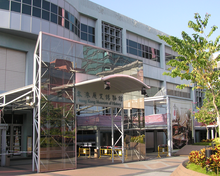
The proposed conference venue is next to East Tsim Sha Tsui, Hong Kong's museum district with a four major museums and other cultural venues along the promenade. We hope that this geographical proximity may boost our efforts in WP:GLAM outreach! A one-week museum pass for all exhibitions in these museums are available for HK$30 (US$4, €3, £3).
- Hong Kong Science Museum. Large museum with many interactive exhibits including a energy machine and an airplane. A museum which decided to make an architectural statement about its purpose, yet somehow got it horribly wrong. Although primarily aimed at children, museum-savvy adults will also certainly find an amazing time playing with the exhibits. The maths puzzles and optical illusions on the top floor are challenging. There is a giant energy machine spanning the entire museum that is run for a few minutes every two hours.
- Hong Kong Museum of History. A history museum in its conventional sense, but better. Experience the Hong Kong Story and forget the idea that all of Hong Kong museums are frumpy and boring. The Hong Kong Story is a real must go and do, ideal for those who want to make sense of Hong Kong's vibrant past in a way that is engaging and interactive. Allow at least two hours for your visit. Special exhibitions are also available, usually covering a specific era in the history of Hong Kong.
- Hong Kong Museum of Art
- Hong Kong Space Museum. Affectionately known as "the egg" by locals, the museum has the oldest planetarium cinema (hence "the egg") in Hong Kong, long before the days of IMAX. It also houses a permanent exhibition on astronomy.
- Hong Kong Cultural Centre. The Cultural Centre is the prime theatre and concert location in Hong Kong, and is the home concert hall of the Hong Kong Philharmonic Orchestra. Despite its peculiar exterior shape, the architecture has created a superb indoor space that is ideal for the sights and sounds of each performance. Its comfortable atmosphere and clean, free lavatories made it a hotspot for locals and tourists alike.
Consulates
Hong Kong has Consulates general for more than 50 nations, some even are the ones of the largest diplomatic mission in the region.
Only Consulates general are listed here (in case of the Portugese Republic, whose CG is located in Macau), there are some nations are represented by Honourary Consuls, please refer to the information on Website of HK Government's Protocol Division.
Financial
Budget
All amounts are in USD.
| Revenue | ||
|---|---|---|
| Regular Registrations | $13,530.93 | 300 people, $32.22 early, $57.99 late |
| Student & Wikimedian Registrations | $14,497.42 | 500 people, $19.33 early, $38.66 late |
| Diamond Sponsorship | $41,237.11 | 1 sponsor. Naming rights to a lounge space, 5 VIP tickets, full-page ad in the program, exhibit table, name & logo prominent on conference website, promotional items in attendee bag, logo prominent on slideshow prior to start of plenary sessions |
| Platinum Sponsorship | $30,927.84 | 1 sponsor. Naming rights to attendee party, 4 VIP tickets, full-page ad in the program, exhibit table, name & logo prominent on conference website, promotional items in attendee bag, logo prominent on slideshow prior to start of plenary sessions |
| Gold Sponsorships | $57,989.69 | 3 sponsors @ $19,329.90. Naming rights to a lunch break, 3 VIP tickets, half-page ad in the program, exhibit table, name & logo prominent on conference website, promotional items in attendee bag, logo prominent on slideshow prior to start of plenary sessions |
| Silver Sponsorships | $72,164.95 | 7 sponsors @ $10,309.28. Two VIP tickets, naming rights to a coffee break or breakfast, quarter-page ad in the program, exhibit table, name & logo on conference website, promotional items in attendee bag, logo on slideshow prior to start of plenary sessions |
| Bronze Sponsorships | $74,097.94 | 10 sponsors @ $7409.79. Two VIP tickets, acknowledgement in the program, name & logo on conference website, name on slideshow prior to start of plenary sessions |
| Total Revenue | $304,445.88 | |
| Expenditures | ||
| Meals | $94,458.76 | Includes a light breakfast and lunch, as well as coffee breaks.
Here is a breakdown of the budgeted total: Budgeted total
|
| Meeting space | $45,876.29 | |
| Accommodations for VIPs | $5,154.64 | For out-of-town VIPs. |
| Travel for VIPs | $7,087.63 | VIPs accounted for in this line item are primarily keynote speakers and community leaders |
| Insurance | $12,886.60 | |
| Scholarships | $51,546.39 | A "full ride" to Wikimania for someone outside the continent. |
| Technical | $6,443.30 | |
| Promotional materials & supplies | $12,242.27 | Includes t-shirts. |
| Participant gift bags | $4,123.71 | 1000 bags — we will use in-kind donations for the items |
| Attendee party | $11,597.94 | |
| VIP reception | $19,329.90 | |
| Volunteer appreciation | $1,159.79 | Comped registration and goodies for volunteering Georgetown students |
| Conference consultant | $2,061.86 | |
| Contingency | $30,476.80 | |
| Total Expenditures | $304,445.88 | |
Local sponsorship opportunities
DotAsia, the sponsoring organization and registry operator of the .asia top-level domain, has agreed to be a co-organizer and sponsor of Wikimania 2013 in Hong Kong. DotAsia was a sponsor of Wikimania 2007 in Taipei, and has a long-standing working partnership with Wikimedia Hong Kong in conference organization, in particular the Asia Pacific Regional Internet Conference on Operational Technologies (APRICOT) and the Regional Internet Governance Forum (RIGF). Through DotAsia, Wikimedia Hong Kong is currently approaching past sponsors of APRICOT and RIGF for further sponsorship opportunities. The Chapter is also in touch with relevant government department, to ask for support. So far positive replies was perceived.
Media and public relations

As one of the world's leading international financial centres, Hong Kong is home to many of Asia's biggest media players. The loose regulation over the establishment of a newspaper makes Hong Kong home to many international media such as Asian Wall Street Journal and FEER, and a number of prominent international broadcasters with studios & offices in Hong Kong, including CNN & Bloomberg, or at least correspondents in Hong Kong covers local affairs and events in the nearby region. With one of the world's largest press industries Hong Kong is also a major centre for print journalism.
By 2009, 4.3 million Hong Kong residents were online, a penetration rate of nearly 70% (official statistics), and new media & social media is popular and vibrant in the town. Social media & Internet related events are celebrated all around the year in the City, including Web-Wednesdays and Barcamp.
Local media outlets
Full list of media outlets in Hong Kong
| |||||||||||||||||||||||||||||||||||||||||||||||||||||||||||||||||||||||||||||||||||||||||||||||||||||||||||||||||||||||||||||||||||||||||||||||||||||||||||||||||||||||||||||||||||||||||||||||||||||||||||||||||||||||||||||||||||||||||||||||||||||
|---|---|---|---|---|---|---|---|---|---|---|---|---|---|---|---|---|---|---|---|---|---|---|---|---|---|---|---|---|---|---|---|---|---|---|---|---|---|---|---|---|---|---|---|---|---|---|---|---|---|---|---|---|---|---|---|---|---|---|---|---|---|---|---|---|---|---|---|---|---|---|---|---|---|---|---|---|---|---|---|---|---|---|---|---|---|---|---|---|---|---|---|---|---|---|---|---|---|---|---|---|---|---|---|---|---|---|---|---|---|---|---|---|---|---|---|---|---|---|---|---|---|---|---|---|---|---|---|---|---|---|---|---|---|---|---|---|---|---|---|---|---|---|---|---|---|---|---|---|---|---|---|---|---|---|---|---|---|---|---|---|---|---|---|---|---|---|---|---|---|---|---|---|---|---|---|---|---|---|---|---|---|---|---|---|---|---|---|---|---|---|---|---|---|---|---|---|---|---|---|---|---|---|---|---|---|---|---|---|---|---|---|---|---|---|---|---|---|---|---|---|---|---|---|---|---|---|---|---|---|---|---|---|---|---|---|---|---|---|---|---|---|---|---|---|---|
|
From the experience of previous Chinese Wikimedia Conference the local commercial print media, that would be interested in covering various aspects of this event. A new trend that is different from the situation in 2006, for Hong Kong print media is free newspapers, and most of which belongs to a group with a paid newspaper, are more and more popular.
2 broadcast television networks, ATV and TVB, and several subscription networks are available for the public in Hong Kong, and most of them are produced and broadcasted in a digital television format. All the networks have extensive local news broadcasts, and some with a 24/7 channel dedicated on real-time news programs. Some of them are particularly broadcasts in public transports and open spaces such as shopping arcade. The public broadcaster RTHK also produced current affairs program, though without her own channels, the program had to broadcast via the networks.
Hong Kong is home to a variety of radio stations that offer programming in Cantonese & English, and a few in languages of different ethnic groups in the territories. Aside from local AM and FM radio channels, online radio is also booming.
|
Media interest
The Wikimania conference has been covered nearly every year by the New York Times, and we anticipate that coverage by these major media from all around the world would increase were the 2013 conference to be held in Hong Kong, because of most of these media have their own correspondent in Hong Kong all the time. Experience from previous Chinese Wikimedia Conference also tell us, such international event will bring local media coverage as well, and a number of them are constantly in touch with the Communication Commission of the Hong Kong Chapter. Keynote speakers of high caliber will also help to bring in additional media interest, and the bid team is prepared to coordinate media engagement throughout the event, as a number of volunteers are actually working within the media sector or under professional journalism training.
Miscellaneous
Currency & money matters
The Hong Kong dollar (港幣 or HKD) is the territory's official currency and is the unit of currency used throughout this travel guide. In Chinese, one dollar is known formally as the yuen (圓) and colloquially as the men (蚊) in Cantonese. You can safely assume that the '$' sign used in the territory refers to HKD unless it includes other initials (e.g. US$ to stand for US Dollar). The HKD is also widely accepted in Macau in lieu of their home currency at a 1:1 rate.
Currency exchange desks are available at airport, as well as at most banks. Australian Dollar, Canadian Dollar, Renminbi, Euro, Indian Rupee, Japanese Yen, Macau Pataca, Malaysian Ringgit, New Zealand Dollar, Singaporean Dollar, South African Rand, South Korean Won, Swiss Franc, Taiwanese Dollar, Thai Baht, Pound Sterling & US Dollar are all widely exchanged.
| ||||||||||||||||||||||||||||||||||||||||||||||||||||||||||||||||||

Automated Teller Machines (ATM's) are common in urban areas. They usually accept VISA, MasterCard, and to certain degree UnionPay. Maestro and Cirrus cards are widely accepted also. They dispense $100, $500 or rarely $1000 notes depending on the request. Credit card use is common in most shops for major purchases. Most retailers accept VISA and MasterCard, and some accept American Express as well. Maestro debit cards however are not widely accepted by retailers. Signs with the logo of different credit cards are usually displayed at the door to indicate which cards are accepted.
Octopus card
The Octopus card (八達通, Bat Dat Toong in Cantonese,) provides instant electronic access to Hong Kong's public transport system. As the world's first contactless smart debit card, it can be tapped onto a reader to transfer fare from the passenger to the carrier. Those who are familiar with Singapore's eZ-Link card, London Underground's Oyster card or Japan Railway's IC cards will quickly understand the concept of the Octopus card. In addition to being used for all forms of public transport (except most of the red-top minibuses and taxis), Octopus is also accepted for payment in almost all convenience stores, restaurant chains like McDonald's and Cafe de Coral, many vending machines, all roadside parking and some car parks. Some housing estates and schools use the card for identification at entry. The Octopus card functionality can also come in the form of personalised cards, ornaments, keychains and watches which you can pre-order at http://octopuscards.com if you're interested.
Cost of living
Mobile Network & Wifi
For an access to commercial WIFI hot spots mainly provided by PCCW and Y5ZONE, $9 will buy you one week of unlimited usage (Nov 2011). Those companies also have daily, weekly and monthly plan ($20 and $13 per month for PCCW and Y5ZONE, respectively). In some restaurants such as McDonald's and café as Starbucks, you can also have 20 minutes of free WIFI access provided by Y5ZONE.
Most hotels these days, even down market ones, provide Wi-Fi access to their guests.
You can also find free wifi in some shopping malls and the airport, which some of them also provides internet terminals. Citybus and NWFB also provide free wifi service on some of their buses, notably the Cityflyer, the service run by Citybus which connects the downtown Hong Kong Island & Kowloon with the Airport. The government also offers a big network of free WIFI [8] hot spots in most government premises and public libraries.

3G-enabled phone users can choose a temporary 3G plan from different operators. Some operators, offer an unlimited 3G access for a week with a reasonable price. Getting a sim card is straightforward and hassle free, just go to a mobile phone shop, pay your money and get a card. No registration is needed.
| Network / ISP | minimum pre-stored value HKD |
budget for 7 days (USD) |
|---|---|---|
| Three (3HK) | 98 | 25.26 |
| SmarTone | 48 | 21.65 |
| one2free | 48 | 10.05 |
| PCCW | 68 | related the data usage |
| CMHK | 88 | 4.90 |
Gallery: Places of Interest
-
The Peak Tower
-
Dim Sum
-
Happy Valley Racecourse at night
-
Tai O Market
-
Repulse Bay
-
A sightseeing Sampan of Aberdeen
-
Cantonese Opera
-
Jumbo Kingdom at night
-
The market in Apliu Street
-
Wong Tai Sin Temple
-
Cross Harbour Tunnel
-
Chi Lin Nunnery
-
Symphony of Lights
-
Big Buddha
-
SoHo, a lively dining district
-
Hong Kong Wetland Park
-
Lan Kwai Fong
-
Graffiti of Tsang Tsou Choi aka Emperor of Kowloon
-
Bank of China Tower
-
Mong Kok
-
Statue Square abuts Connaught Road
-
Nathan Road, Jordan section
-
People rush to another line in MTR Admiralty Station
-
Siu Mei/ Cantonese Barbecued food
-
The Peak Tram of Hong Kong
-
Buses at the Tsim Sha Tsui Ferry Pier Terminus
-
Seafood Cuisine store
-
Temple Street
-
Teahouse
-
Tram
-
Egg Tart
-
Star Ferry
-
Pineapple Bun
-
Ngong Ping 360
-
Rice Roll
Self-evaluation
- Weaknesses of the proposed location ...and how to overcome those weaknesses
- Weather conditions in August
- The weather in Hong Kong is hot in August. To provide a good environment for the events, the venue is well air-conditioned.
- Some may worry that there are typhoons in Hong Kong as it lies within the typhoon belt. In fact, typhoons that affect Hong Kong seriously are rarely seen, if comparing with other nearby south-east Asian countries. In case the weather is poor, special arrangement will be made.
- Cost can be high
- Accommodation fee is rather high in the region near to the venue. Therefore, we have suggested some lower price hotels which are not too far from the venue.
- Strengths of the proposed location
- Easy to access
- Hong Kong International Airport can be accessed by direct flight from most major cities. The airport connects the downtown, as well as the venue by reliable transportation including buses and the MTR. Also, most vistors to Hong Kong will not need to worry about the visa as most of them can come to Hong Kong visa-free.
- The venue, the Hong Kong Polytechnic University, is located near the Tsim Sha Tsui area, which is the transportation hub in Kowloon downtown, and has so many sightseeing spots.
- There are significant number of Wikipedians in China. It is difficult for mainland Chinese to get the visas for foreign countries, but they can get the permit to Hong Kong more easily. Therefore, having Wikimania in Hong Kong makes an opportunity for Chinese Wikipedians to attend.
- Safety
- Hong Kong is believed to be one of the safest city. According to the figures from the Hong Kong Police Force, the crime rate is much less than other major cities. The chance for Hong Kong being threatened by terrorism is low.
- Freedom of press and no Internet censorship
- Although Hong Kong is part of the People’s Republic of China, the press freedom in Hong Kong is one of the highest in Asia. As there is no Internet censorship, information can be accessed and published freely in Hong Kong.
- Wifi
- Internet can be accessed easily anywhere. Wifi is available in the Wikimania venue, and free unlimited wifi services are available in many places in Hong Kong.
- Reasonable expense
- Comparing with other countries with similar economic standards, the expenses, such as transportation fee, in Hong Kong is inexpensive. Hong Kong is good for shopping as most of expenses are tax-free.
- Basic need available 24/7
- Most of residences will be arranged in the area of Tsim Sha Tsui, Jordan and Hung Hom. In these areas, there are plenty of 24-hour restaurants, and convenience stores can be easily found in nearby. There are also buses and mini-buses providing overnight services so visitors will not need to worry about that it will be too late to return to the hotel.
- Variety of travel opportunity
- As a regional transportation hub in China, as well as in Asia, vistiors to Hong Kong can easily transfer to nearby countries and cities such as Macau and the mainland China.
- Energetic local community
- Hong Kong has a long-existed and energetic Wikipedian community. The community has experienced in organizing the Chinese Wikimedia Conference 2006 in Hong Kong, and 2009 in Macau. The community has regular meet-ups since 2004, recently once a month.
Notes
Parts of the page was adapted from relevant pages from Wikitravel, which are based on work by Claus Hansen, Martin Cox, Samuel Chan, Edison Chua and Bill Ellett, Wikitravel user(s) Globe-trotter, Timeo and Sumone10154, and anonymous editors, released under cc-by-sa 3.0 licence.






